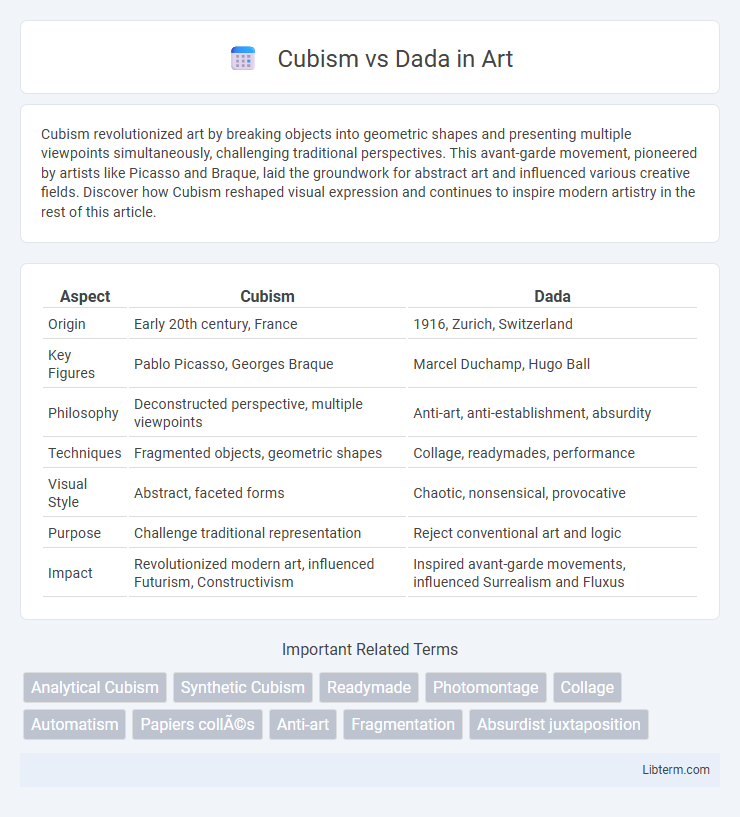Cubism revolutionized art by breaking objects into geometric shapes and presenting multiple viewpoints simultaneously, challenging traditional perspectives. This avant-garde movement, pioneered by artists like Picasso and Braque, laid the groundwork for abstract art and influenced various creative fields. Discover how Cubism reshaped visual expression and continues to inspire modern artistry in the rest of this article.
Table of Comparison
| Aspect | Cubism | Dada |
|---|---|---|
| Origin | Early 20th century, France | 1916, Zurich, Switzerland |
| Key Figures | Pablo Picasso, Georges Braque | Marcel Duchamp, Hugo Ball |
| Philosophy | Deconstructed perspective, multiple viewpoints | Anti-art, anti-establishment, absurdity |
| Techniques | Fragmented objects, geometric shapes | Collage, readymades, performance |
| Visual Style | Abstract, faceted forms | Chaotic, nonsensical, provocative |
| Purpose | Challenge traditional representation | Reject conventional art and logic |
| Impact | Revolutionized modern art, influenced Futurism, Constructivism | Inspired avant-garde movements, influenced Surrealism and Fluxus |
Introduction to Cubism and Dada
Cubism, pioneered by Pablo Picasso and Georges Braque in the early 20th century, revolutionized art by fragmenting objects into geometric shapes and representing multiple perspectives simultaneously. Dada emerged during World War I as an anti-art movement, founded by artists like Hugo Ball and Tristan Tzara, emphasizing chaos, absurdity, and rejection of traditional aesthetics. Both movements challenged conventional artistic norms but with divergent philosophies: Cubism focused on deconstructing form, while Dada embraced irrationality and political protest.
Origins and Historical Background
Cubism emerged in the early 20th century, pioneered by Pablo Picasso and Georges Braque in Paris around 1907, challenging traditional perspectives by depicting subjects through fragmented geometric shapes. Dada originated during World War I, around 1916 in Zurich, as an anti-war, anti-art movement led by artists like Tristan Tzara and Hugo Ball, rejecting conventional aesthetics and embracing absurdity to protest societal norms. Both movements reacted to their historical context--Cubism transforming visual representation amid rapid modernization, and Dada undermining established cultural values in response to the horrors of war.
Key Philosophies and Ideologies
Cubism emphasizes fragmented forms and multiple perspectives to challenge traditional representation in art, highlighting the complexity of visual perception and reality. Dada rejects conventional aesthetics and logic, embracing absurdity and irrationality as a protest against social and political norms post-World War I. Both movements disrupt established art conventions but diverge in approach, with Cubism rooted in analytical exploration and Dada in anti-art activism.
Influential Artists and Works
Cubism, pioneered by Pablo Picasso and Georges Braque, revolutionized art with works like Picasso's "Les Demoiselles d'Avignon" and Braque's "Violin and Candlestick," introducing fragmented perspectives and geometric forms. Dada, led by artists such as Marcel Duchamp and Hannah Hoch, challenged traditional aesthetics through provocative pieces like Duchamp's "Fountain" and Hoch's photomontages, emphasizing absurdity and anti-art sentiments. Both movements significantly influenced modern art by redefining artistic expression and breaking conventional boundaries.
Techniques and Aesthetic Approaches
Cubism employs fragmented geometric shapes and multiple perspectives to depict subjects, emphasizing abstraction and spatial complexity through techniques like collage and analytic cubism. Dada challenges traditional aesthetic norms by embracing randomness, absurdity, and anti-art sentiments, using techniques such as photomontage, readymades, and performance art to provoke emotional and intellectual reactions. While Cubism focuses on deconstructing visual reality to explore structure and form, Dada adopts a chaotic, irreverent aesthetic aimed at disrupting cultural conventions and societal expectations.
Role of Abstraction and Symbolism
Cubism revolutionized art through fragmented abstraction, breaking subjects into geometric shapes to represent multiple perspectives simultaneously, emphasizing visual perception over symbolic meaning. Dada, conversely, employed abstraction as a form of anti-art rebellion, using chaotic, nonsensical imagery and ready-made objects to challenge traditional symbolism and provoke critical reflection on societal norms. Both movements utilized abstraction and symbolism distinctly: Cubism for analytical deconstruction of reality, and Dada for anarchic critique and rejection of conventional artistic values.
Impact on Modern and Contemporary Art
Cubism revolutionized visual art by introducing fragmented perspectives and abstract forms, profoundly influencing modernist movements like Futurism and Constructivism. Dada challenged traditional aesthetics and cultural norms through its embrace of absurdity and anti-art sentiments, paving the way for conceptual art and performance pieces. Together, Cubism and Dada reshaped the boundaries of artistic expression, directly impacting the evolution of contemporary art practices such as Abstract Expressionism and Fluxus.
Cultural and Social Context
Cubism emerged in the early 20th century as a revolutionary art movement that challenged traditional perspectives by fragmenting objects into geometric shapes, reflecting the rapidly changing industrial society and scientific advancements. Dada arose during World War I as a radical cultural response to the horrors and absurdity of the conflict, embracing chaos, irrationality, and anti-establishment ideals to critique prevailing social norms and politics. Both movements, though distinct, encapsulated the tensions of their eras, with Cubism mirroring modernity's complexity and Dada embodying disillusionment and resistance to conventional values.
Differences in Artistic Intent and Expression
Cubism deconstructed objects into geometric shapes to explore multiple perspectives, aiming to represent reality through structured abstraction. Dada rejected traditional aesthetics entirely, embracing chaos and irrationality to challenge societal norms and provoke anti-art sentiments. While Cubism sought intellectual reinterpretation of form, Dada emphasized spontaneous, anarchic expression as a critique of cultural conventions.
Legacy and Lasting Influence
Cubism revolutionized modern art by introducing fragmented perspectives and abstract forms, profoundly influencing 20th-century painting and design. Dada challenged traditional aesthetics through its embrace of absurdity and anti-art principles, paving the way for conceptual art and performance. Both movements significantly shaped contemporary visual culture, inspiring artists to explore new creative boundaries and social critiques.
Cubism Infographic

 libterm.com
libterm.com